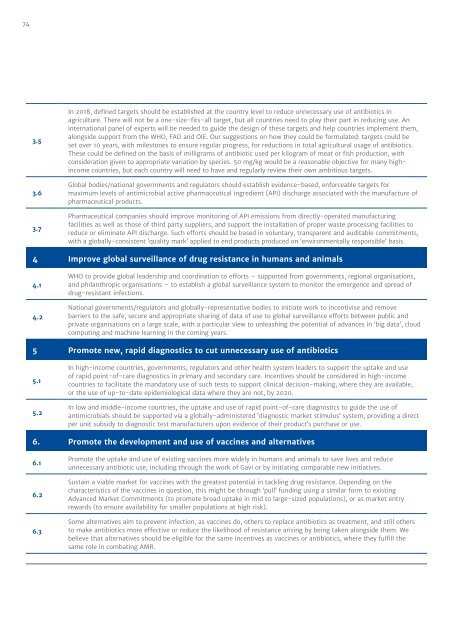TACKLING DRUG-RESISTANT INFECTIONS GLOBALLY FINAL REPORT AND RECOMMENDATIONS
qQvJ300ETXu
qQvJ300ETXu
Create successful ePaper yourself
Turn your PDF publications into a flip-book with our unique Google optimized e-Paper software.
74<br />
3.5<br />
3.6<br />
3.7<br />
In 2018, defined targets should be established at the country level to reduce unnecessary use of antibiotics in<br />
agriculture. There will not be a one-size-fits-all target, but all countries need to play their part in reducing use. An<br />
international panel of experts will be needed to guide the design of these targets and help countries implement them,<br />
alongside support from the WHO, FAO and OIE. Our suggestions on how they could be formulated: targets could be<br />
set over 10 years, with milestones to ensure regular progress, for reductions in total agricultural usage of antibiotics.<br />
These could be defined on the basis of milligrams of antibiotic used per kilogram of meat or fish production, with<br />
consideration given to appropriate variation by species. 50 mg/kg would be a reasonable objective for many highincome<br />
countries, but each country will need to have and regularly review their own ambitious targets.<br />
Global bodies/national governments and regulators should establish evidence-based, enforceable targets for<br />
maximum levels of antimicrobial active pharmaceutical ingredient (API) discharge associated with the manufacture of<br />
pharmaceutical products.<br />
Pharmaceutical companies should improve monitoring of API emissions from directly-operated manufacturing<br />
facilities as well as those of third party suppliers, and support the installation of proper waste processing facilities to<br />
reduce or eliminate API discharge. Such efforts should be based in voluntary, transparent and auditable commitments,<br />
with a globally-consistent ‘quality mark’ applied to end products produced on ‘environmentally responsible’ basis.<br />
4 Improve global surveillance of drug resistance in humans and animals<br />
4.1<br />
4.2<br />
WHO to provide global leadership and coordination to efforts – supported from governments, regional organisations,<br />
and philanthropic organisations – to establish a global surveillance system to monitor the emergence and spread of<br />
drug-resistant infections.<br />
National governments/regulators and globally-representative bodies to initiate work to incentivise and remove<br />
barriers to the safe, secure and appropriate sharing of data of use to global surveillance efforts between public and<br />
private organisations on a large scale, with a particular view to unleashing the potential of advances in ‘big data’, cloud<br />
computing and machine learning in the coming years.<br />
5 Promote new, rapid diagnostics to cut unnecessary use of antibiotics<br />
5.1<br />
5.2<br />
In high-income countries, governments, regulators and other health system leaders to support the uptake and use<br />
of rapid point-of-care diagnostics in primary and secondary care. Incentives should be considered in high-income<br />
countries to facilitate the mandatory use of such tests to support clinical decision-making, where they are available,<br />
or the use of up-to-date epidemiological data where they are not, by 2020.<br />
In low and middle-income countries, the uptake and use of rapid point-of-care diagnostics to guide the use of<br />
antimicrobials should be supported via a globally-administered ‘diagnostic market stimulus’ system, providing a direct<br />
per unit subsidy to diagnostic test manufacturers upon evidence of their product’s purchase or use.<br />
6. Promote the development and use of vaccines and alternatives<br />
6.1<br />
6.2<br />
6.3<br />
Promote the uptake and use of existing vaccines more widely in humans and animals to save lives and reduce<br />
unnecessary antibiotic use, including through the work of Gavi or by initiating comparable new initiatives.<br />
Sustain a viable market for vaccines with the greatest potential in tackling drug resistance. Depending on the<br />
characteristics of the vaccines in question, this might be through ‘pull’ funding using a similar form to existing<br />
Advanced Market Commitments (to promote broad uptake in mid to large-sized populations), or as market entry<br />
rewards (to ensure availability for smaller populations at high risk).<br />
Some alternatives aim to prevent infection, as vaccines do, others to replace antibiotics as treatment, and still others<br />
to make antibiotics more effective or reduce the likelihood of resistance arising by being taken alongside them. We<br />
believe that alternatives should be eligible for the same incentives as vaccines or antibiotics, where they fulfill the<br />
same role in combating AMR.


